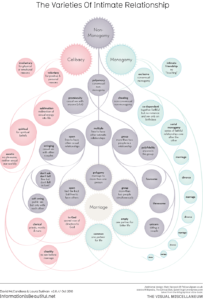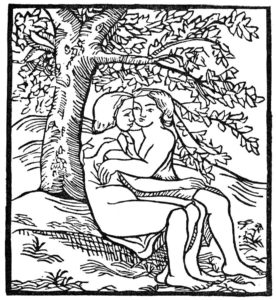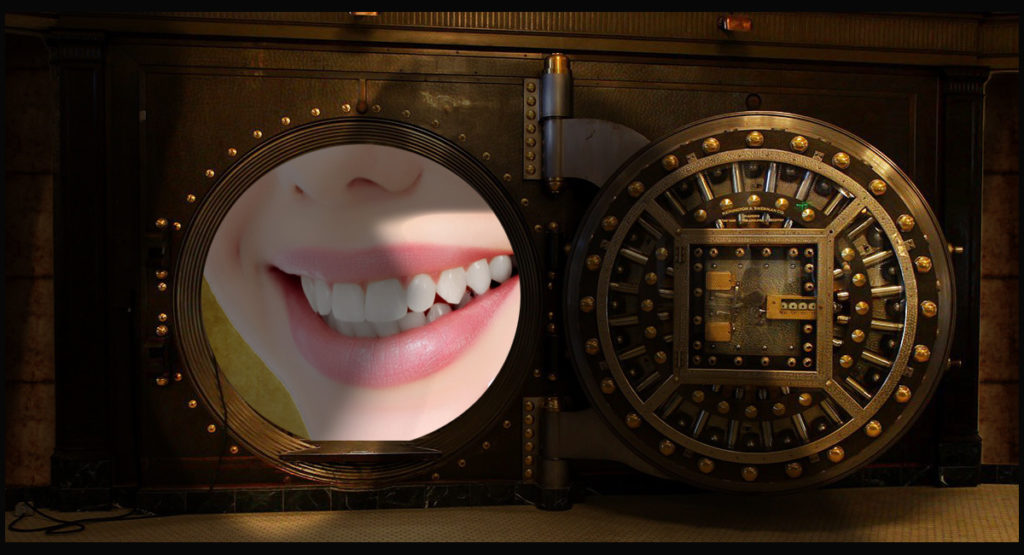Society
To the right is a relationship flowchart by the elegant artists and thinkers of Information is Beautiful. They have a lot of fun and interesting stuff to explore. The image is linked to a full-size version, it may take 2 clicks to open it fully.
All these forms of intimate relationships are going on around us right now. Some are movements and subcultures, some are just deeply personal rabbit holes. Many are virtually invisible through fear of disapproval. Polyamourous people are probably as low profile now as gays and lesbians were in the late sixties.  These varieties can be understood as a range of human love styles but also as strategic experiments running parallel to the accepted norms. The norms are pretty obviously the mating styles that do the best job of creating robust and stable populations. That has clear evolutionary significance and suggests a reason for cultural pressure to stay inside the lines. Yet these variations show up within every generation of people. Perhaps life maximizes chances for success by keeping alternate pathways running should fortune suddenly favor them. Since these variants are visible as an emergent, bottom-up effect from the desires and needs of individual people, we can predict them appearing in some ratio within any population, in any circumstances, anywhere on earth. If we imagine small tribes in many different challenging conditions attempting to survive, it’s easy to see how one of these variations might prove more advantageous than straight up monogamy. That makes it evolutionary common sense to preserve these alternate strategies inside the human heart.
These varieties can be understood as a range of human love styles but also as strategic experiments running parallel to the accepted norms. The norms are pretty obviously the mating styles that do the best job of creating robust and stable populations. That has clear evolutionary significance and suggests a reason for cultural pressure to stay inside the lines. Yet these variations show up within every generation of people. Perhaps life maximizes chances for success by keeping alternate pathways running should fortune suddenly favor them. Since these variants are visible as an emergent, bottom-up effect from the desires and needs of individual people, we can predict them appearing in some ratio within any population, in any circumstances, anywhere on earth. If we imagine small tribes in many different challenging conditions attempting to survive, it’s easy to see how one of these variations might prove more advantageous than straight up monogamy. That makes it evolutionary common sense to preserve these alternate strategies inside the human heart.
Different strategies can become the social norm in different cultures, and be seen as the ideal, natural version of love and marriage. Monogamy is the widest spread, most successful pattern historically but the fact that it isn’t universal and is seen as less than ideal in various other cultures has an important implication. It means that the cultural machinery doesn’t come with a preset mating strategy installed but adopts whichever mating pattern becomes dominant and reinforces it. Apparently, the larger survival value is in a culture-wide agreement about our common strategy. A culture without a dominant strategy is not a fully defined culture.
It’s intriguing that in America the variations in the chart are all legal to pursue…as hobbies. But illegal as forms of marriage. Gays and lesbians have finally been recognized as normal citizens with a right to marry, but only within the one, true marriage pattern. This shows the intense cultural defense of the dominant strategy. There’s a fear of society losing definition and becoming nonfunctional without a law of marriage. Polygamy (multiple wives) and polyandry (multiple husbands) are illegal here along with group marriage. But as long as you don’t try to stick a ring on it, the law isn’t coming after you. That’s a job for your fellow citizens, creeped out by your weird arrangement which looks to them like the marriage equivalent of a person with three arms and seven eyes. Continue reading
Crowd control at a huge event in Japan.
How falling in love differs from online dating. 
Falling in love
Love doesn’t arrive like a bus. Love arrives as a slow reveal, an awakening, a dawn. It doesn’t take an assigned seat or speak in plain sentences. Love needs propinquity to confidently find its way. Love needs to bump against the beloved and smell them. Love needs to watch the beloved from the corner of its eye. Love is exited eventually when it has warmed to the subject and faced the facts. Disliking the spotlight, love stirs in shadows telling you with urgent whispers that you have become vulnerable to that person with the extraordinary smile.
You will no longer be able to not notice them. As of now, you will worry over whether they notice you. Their face and words, lovely to you now, host uncertainties that trouble your sleep. Typically, at this point, love must pretend it doesn’t exist, at least for a time. This is as graceful as hiding a cow under a sheet. It makes normal life a self-conscious burden. Flirting with your love is as disorienting as a sudden accident where time distorts and details flicker and swoop.
Mostly, love will die on this vine, either tethered to silence or offered and declined.
But when love and love stand naked face to face, desire is the bridge. From both sides to the middle, they run. And something new is born.
Online dating
An ordinary e-commerce database replaces item color with ethnicity and product description with the story of your heart’s longing to find a home. Each human transforms, upon entry, into a product.
Each product describes itself and the product it hopes to find in turn. In their profiles, each product makes their case to be understood and recognized for their divine spark. Each provides photo evidence. Each provides lists of activities and music and food in hopes of being found and adopted by a stranger they will find it effortless to love.
The product automatically generates a query and when enough data points correlate, results cascade or trickle before the querent in rows of common faces, names, ages, and isolated facts. Carol, 47 Speaks English. Laura, 44 has cats. The querying product wanders through the matrix-like results looking for something that stands out from the vending machine assortment as somehow, more than a product. And it happens, a certain beauty or quirk distinguishes a profile and we browse deeper. We carefully seek evidence both pro and con about the candidate. Are they fresh and funny, does a selfie reveal the honest fat hiding behind the word voluptuous? Is there some terrible band waiting to appear in her favorite music? What do we do with that knowledge? Perhaps we LIKE them, which might be a request for contact or merely a vague seal of approval in passing. All that is left is to either reach out to them or turn and leave.
If we message them and if they reply, and if we survive the labyrinth of failed texting outcomes, each ending like a dead branch, we may achieve a date.
And if we date, two individuals composed of meat and hope find each other on the earth. At this point, we receive a lesson about how little our data points actually count toward the goal we’ve pursued. Our data points felt like investment capital online but here in this restaurant or coffee shop, they are dwarfed to trivia by the God of Chemistry.
Whenever two of us meet, the god of chemistry reveals the truth of our experiment in a court of no appeal. Over that hour or two we take in the truth, adjust expectations, swallow disappointment, and treat each other as we would want to be treated. We sit there at least briefly cast in the role of everything the other person was praying for and to them we look wrong and miscast in that role and the whole thing seems a bit crazy, now, how real this felt while texting.
 Brooks Adams believed that commercial civilizations rise and fall in predictable cycles. First, masses of people draw together in large population centers and engage in commercial activities. As their desire for wealth grows, they discard spiritual and creative values. Their greed leads to distrust and dishonesty, and eventually, the society crumbles. In The Law of Civilization and Decay (1895), Adams noted that as new population centers emerged in the west, centers of world trade shifted from Constantinople to Venice to Amsterdam to London. He predicted in America’s Economic Supremacy (1900) that New York would become the center of world trade.
Brooks Adams believed that commercial civilizations rise and fall in predictable cycles. First, masses of people draw together in large population centers and engage in commercial activities. As their desire for wealth grows, they discard spiritual and creative values. Their greed leads to distrust and dishonesty, and eventually, the society crumbles. In The Law of Civilization and Decay (1895), Adams noted that as new population centers emerged in the west, centers of world trade shifted from Constantinople to Venice to Amsterdam to London. He predicted in America’s Economic Supremacy (1900) that New York would become the center of world trade.
Adams was a great-grandson of John Adams, a grandson of John Quincy Adams, the youngest son of U.S. diplomat Charles Francis Adams, and brother to Henry Adams, philosopher, historian, and novelist, whose theories of history were influenced by his work. His maternal grandfather was Peter Chardon Brooks, the wealthiest man in Boston at the time of his death. He was elected a Fellow of the American Academy of Arts and Sciences in 1918.
The political debate in the United States has gradually developed a tacit consensus that if ordinary people try to advance their interests they are being self indulgent and childish. Yet advancing the interests of the wealthy and powerful, “the owners” as George Carlin put it, is sensible, mature and realistic. It isn’t surprising since untold millions have been spent to achieve this version of common sense.
Our government has become the agent of the owners against the people of the United States. We pay absurd prices for health care, internet access, etc., because the free market is suppressed by the owners conspiring against us. If our lives are spent struggling to work enough to stay afloat and to keep paying interest on our debt for school or home or medical care, if out our lives are diminished or even endangered it doesn’t matter a shred to the owners. We exist to pay them. That’s why we are here. We are payment units. It doesn’t matter if we are happy or healthy, we exist to maximize their profit.
The owners demand to be in charge of every area of our lives, to make each a service they own and allocate at minimum quality and cost for maximum profit. They want the roads and highways, they want our schools and postal service, they want the armed services and prisons. They own the non-governmental services of health care and insurance and communications and internet access and so much more. They want us to have nothing of our own, nothing independent of them. Nothing will be corrected by “Market forces”. The government is being used by the owners to suppress market forces for the elite. Continue reading
The most intractable problems of this jittery moment come from the human sweet-tooth for conflict and excitement. The sweet-tooth is natural, it is good or bad by context. If you are an ancient human and opt to look at the exciting thing, you are better at staying alive. If you are an ancient human and your clan starts getting pumped up over increasing tension with another clan, you are your clan are more cohesive and motivated. In this context the “sweet tooth” is a healthy (pro-survival) relationship to your environment. It’s a bit like our love of actual sugar, fat and salt: That love becomes destructive when these go from rare, random windfalls to a superabundance. When we can have as much of something as we like, we keep mashing the button till we find out how that ruins us. Morbid obesity is what THAT button does. What does this other one do?
Our hunger for excitement and conflict became more complicated when our “news” input went from direct observation and word of mouth to massive information pumps like newspapers that could flood a large city in a day with a single message and point of view. Thousands of opinions could be massaged and tweaked at once. “Yellow journalism” was the click-bait of that time. The radio hit people like a massively purified version of the newspaper drug. Music and voices could hit sweet spots in our monkey guts that letters on paper could only dream about and rather than the isolated one-at-a-time experience of newspapers, radio could flow like a connecting current though everyone in earshot. And everyone was within earshot. Then the television became a cultural charging station in the center of every home. At night we were quietly filled with a homogeneous informational snapshot of the day. Of course we felt more united, any axes we were grinding were not wirelessly communicating with all the other axes. You couldn’t make that world combust because there was no connecting medium of petrol fumes.
The issue now is that we are a different organism as flashing, participating virtual neurons on a network then we were as slow-moving, disconnected creatures who got the news from kids on bikes, or in the mail, god help us, or arriving on the TV like a friendly little train at the same time every day.
The organism we are now is constantly lit up, alert and watching for movement like meerkats on crack. The news equivalent of plasma waves erupting from the sun flare and sweep endlessly across the internet. Our new atmosphere is a highly combustible, volatile medium. The ignition behind these flare-ups is mostly outrage, as one group or another does a “football stadium wave” of alarm in response to some stimulus. Tsunamis of cortisol are washing over us 24/7, leaving us feeling hypervigilant and weary.
Why? Because we are idiots who like that sort of thing. We can’t help being idiots who like that sort of thing…BECAUSE WE LIKE THAT SORT OF THING. Part of the rush is certainly negative but part of it is the fun of holding hands with like-minded neurons and cascading as a gigantic wave across the world. It’s thrilling because we are playing with a new level of complexity and connection.
We are a new species variant of humans and we are figuring out what this human is, what it does and what it can do.
And because we are the only animal enemy we have left, we are looking for its weaknesses; feeling around for its windpipe, thumbs and eyes.
The danger from this all-out competition for eyeballs and clicks is low except where real territorial stuff is on the line. There, virality means masses of people losing control of themselves and losing all sense of proportion. You know, like angry mobs.
“The further a society drifts from the truth, the more it will hate those that speak it.”
– George Orwell

My son is leaving middle school and is headed for high school next year. His school had a “Progression Ceremony” for the departing eighth graders. It’s not a graduation, but it is a serious milestone. A summer evening, beautiful outside: Hundreds of parents and separately, hundreds of children, waited in the auditorium then listened to some short speeches by students and faculty over a terrible sound system. Awards were given for exceptional accomplishments, and then, grouped by teacher, the kids were called to the stage by name , one by one. Each group briefly stood together and was cheered and applauded. For a little over an hour.
Part way through the ceremony I realized how utterly profound and beautiful it was to recognize each and every student by name. To literally speak their name loudly announcing their accomplishment before the community. Recognizing them like: “You were here, you affected things, you were seen and appreciated. You persevered to success.” It’s a remarkable moment but even more than that moment for that individual, I was so moved by what really happened AROUND that moment.
In this America, struggling to cohere as a body of citizens, the school pulled a huge neighborhood of strangers with superficially gigantic differences, into one building and warmly reminded them of their fundamental relationship. The principal, staff and teachers reminded everyone of our shared enterprise; a great community, built out of healthy, well nurtured citizens. Nobody would say such a thing out loud of course, but the friendly smiles and chatting as we left reflected a renewed community warmth and openness. It was just one night in one neighborhood but it was important here, and it’s incredibly important that it happens almost everywhere in this country.
I’m so grateful for the public school system even with all my reservations about this and that. Yes it could use some new approaches to things, but the fact that it’s there, slogging through the absurd workload with the absurd budget, is a beautiful thing. It gets the job done as best it can with the sincerest effort I’ve ever seen.
The scam artists who want to sell out public schools for lucrative private contracts, wouldn’t care about the consequences anyway, but they would unstring critical connective tissue holding our country together. They would see the community as consumers and product, not as citizens charged with responsibility for the future.
Let’s get our subject clear by defining the term.
- Meme: an element of a culture or system of behavior that may be considered to be passed from one individual to another by nongenetic means, especially imitation.
- Meme: a humorous image, video, piece of text, etc., that is copied (often with slight variations) and spread rapidly by Internet users.
Memes didn’t begin with Richard Dawkins, Dawkins didn’t raise them and release them into the wild, Dawkins pointed out the existence of memes: He coined the term and the concept. The word meme ITSELF is a meme that spread quickly and burrowed into our collective intellectual DNA. Memes are often described as viral, but why?
Viruses are self replicating genetic mechanisms which are not alive. They must find living cells to highjack and use their machinery to replicate themselves. Imagine a computer virus as a script instructing itself: “Look for places to copy yourself and copy yourself to them. Loop.” Likewise a meme must find a living and communicating host to live and replicate. Memes are contagious human ideas and behaviors. Left at that level of definition it’s too broad. We need to understand the roles they play in the ecosystem of human behavior and establish a taxonomic ranking of types.
The universality of memeing is obvious. We share things on purpose and even joyfully. “Look at this!” It’s innate to share ideas and to mirror behavior. From an evolutionary perspective it makes sense as a way of enhancing survival (hey this plant is good to eat!) both for yourself and someone you likely shared genes with. But just as important, Memeing is critical to defining the cultural “self” of human groups. Every group of people unconsciously begin mirroring each other and a context and a style evolve, mapping out a behavioral grid. We’re very good at catching on to these invisible but obvious rules and sort of domesticating our own style to fit in. The group systematically begins developing stories and injokes that reinforce the culture in miniature. It also starts to establish a dominance scale, cliques, gossip and social outcasts. When we are face to face, this mirroring and blending of styles is at its most intimate and powerful. Teenagers often agonize as they struggle with this new matrix of social complexity, and in this we can see our own exposed heart and how very much it matters. A good bit of comedy involves violating or mistaking these social rules. These are social/behavioral memes but there are many kinds. Continue reading
Natural does not equal good. “Natural” includes violence toward outlanders and controlling women’s lives. I suspect “100% Natural” is a phrase Hitler would have liked.
Some questions we ought to ask:
- Why is there war? Why does xenophobia appear in every culture? Why does everyone have a culture? Why does virtually every culture come with a religion? Why do most cultures/religions form defensive barriers against each other?
- Why is it so common for people (men and women) in so many different cultures, to feel that they have a vote in how women should dress and behave, but almost never show that kind of concern about men? (The general exception being harassing effeminate men).
- Why are the young predictably liberal, and the old generally conservative?
- Why are liberal and conservative political stances universal within technological societies but always relative to local cultural details? (“I treat my slaves gently, they last longer that way”: Is that a progressive or conservative statement?)
- Why are people predictably kind to the rich and famous…but cruel to the poor? (Spoiler alert: It’s because we’re self-interested bastards who do it automatically.)
All of these behaviors are core hardwired human group traits that support a strong and stable primate hive. These behaviors aren’t beautiful or right philosophically, they are bits of scripting preserved by the natural selection of group behaviors. These are traits that helped us out-compete the good, the bad and possibly the ugly, over the last 200k years.
We are virtually blind to our nature as a species because we are so busy being individuals of our species. We are neurologically immersed in the matrix of these behaviors to the extent that they are not noteworthy. We feel like peripheral players at best to the great events of our time even though these movements are composed entirely of peripheral players. The larger picture is composed of us “pixels” forming the colors, shapes, and gradients, with our massed actions. And just as a cloud doesn’t exist without micro-droplets, human events don’t exist without us in our drifting collective groups. Every notable trend in our world emerges from the scaling up of the actions of individuals who generally feel no personal control over what is happening around them: Most people feel they are just tagging along trying to keep up and figure things out. The mirror of current events is too broad for us to recognize ourselves. It’s as if the sky was a mirror where we could see our city reflected but not our own little face peering up from it.
The behavior of large human groups is almost opaque to us in the same way that a cell knows nothing about the particular body it devotes every moment to supporting. We plug away at our daily business in much the same fashion. For many decades science fiction writers have explored the issues of robots and their programming and the nature of free will. I think it’s one of those ideas that is compelling because it echoes something deep and unresolved in ourselves, a bit like a profound but confusing dream. In a world where the first semiconscious robot has yet to ask if we want fries with that, the subject is clearly ourselves. Are we…free? Continue reading
